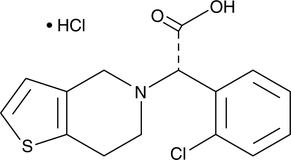Cayman
Showing 15751–15900 of 45550 results
-
Clevidipine is an inhibitor of L-type calcium channels (IC50s = 7.1 and 78.8 nM at -40 and -80 mV, respectively, in isolated guinea pig cardiomyocytes).{36177} It preferentially inhibits L-type calcium channels in isolated rat portal vein over rat left ventricle (IC50s = 427 and 20,417 nM, respectively).{36176} Clevidipine decreases mean arterial pressure in anesthetized normotensive or spontaneously hypertensive rats with ED30 values of 316 and 58 nmol/kg, respectively. Formulations containing clevidipine have been used in the treatment of hypertension.
Brand:CaymanSKU:23025 - 100 mgAvailable on backorder
-
Clevidipine is an inhibitor of L-type calcium channels (IC50s = 7.1 and 78.8 nM at -40 and -80 mV, respectively, in isolated guinea pig cardiomyocytes).{36177} It preferentially inhibits L-type calcium channels in isolated rat portal vein over rat left ventricle (IC50s = 427 and 20,417 nM, respectively).{36176} Clevidipine decreases mean arterial pressure in anesthetized normotensive or spontaneously hypertensive rats with ED30 values of 316 and 58 nmol/kg, respectively. Formulations containing clevidipine have been used in the treatment of hypertension.
Brand:CaymanSKU:23025 - 25 mgAvailable on backorder
-
Clevidipine is an inhibitor of L-type calcium channels (IC50s = 7.1 and 78.8 nM at -40 and -80 mV, respectively, in isolated guinea pig cardiomyocytes).{36177} It preferentially inhibits L-type calcium channels in isolated rat portal vein over rat left ventricle (IC50s = 427 and 20,417 nM, respectively).{36176} Clevidipine decreases mean arterial pressure in anesthetized normotensive or spontaneously hypertensive rats with ED30 values of 316 and 58 nmol/kg, respectively. Formulations containing clevidipine have been used in the treatment of hypertension.
Brand:CaymanSKU:23025 - 50 mgAvailable on backorder
-
Clevudine is a β-L-nucleoside analog of thymidine (Item No. 20519) that has antiviral activity.{53860,53861,53862} It is active against hepatitis B virus (HBV) in HepG2/2.15 cells with an EC50 value of 0.1 µM.{53862} Clevudine (0.01-10 µM) reduces virion DNA in the culture supernatant of primary hepatocytes isolated from a duckling model of chronic HBV infection.{53863} Oral administration of clevudine (3 and 10 mg/kg) reduces serum viral load in a woodchuck model of chronic HBV infection.{53864}
Brand:CaymanSKU:30612 - 100 mgAvailable on backorder
-
Clevudine is a β-L-nucleoside analog of thymidine (Item No. 20519) that has antiviral activity.{53860,53861,53862} It is active against hepatitis B virus (HBV) in HepG2/2.15 cells with an EC50 value of 0.1 µM.{53862} Clevudine (0.01-10 µM) reduces virion DNA in the culture supernatant of primary hepatocytes isolated from a duckling model of chronic HBV infection.{53863} Oral administration of clevudine (3 and 10 mg/kg) reduces serum viral load in a woodchuck model of chronic HBV infection.{53864}
Brand:CaymanSKU:30612 - 250 mgAvailable on backorder
-
Clevudine is a β-L-nucleoside analog of thymidine (Item No. 20519) that has antiviral activity.{53860,53861,53862} It is active against hepatitis B virus (HBV) in HepG2/2.15 cells with an EC50 value of 0.1 µM.{53862} Clevudine (0.01-10 µM) reduces virion DNA in the culture supernatant of primary hepatocytes isolated from a duckling model of chronic HBV infection.{53863} Oral administration of clevudine (3 and 10 mg/kg) reduces serum viral load in a woodchuck model of chronic HBV infection.{53864}
Brand:CaymanSKU:30612 - 50 mgAvailable on backorder
-
Clevudine is a β-L-nucleoside analog of thymidine (Item No. 20519) that has antiviral activity.{53860,53861,53862} It is active against hepatitis B virus (HBV) in HepG2/2.15 cells with an EC50 value of 0.1 µM.{53862} Clevudine (0.01-10 µM) reduces virion DNA in the culture supernatant of primary hepatocytes isolated from a duckling model of chronic HBV infection.{53863} Oral administration of clevudine (3 and 10 mg/kg) reduces serum viral load in a woodchuck model of chronic HBV infection.{53864}
Brand:CaymanSKU:30612 - 500 mgAvailable on backorder
-
Clidinium is a gastrointestinal muscarinic receptor antagonist (Ki = 3 nM against [3H]quinuclidinyl benzilate binding in rat colonic enterocytes).{39282} Administration of clidinium, at a dose of 1 mg/kg, slows intestinal transit and induces constipation in mice.{39283} This clidinium-induced constipation induces serum hyperammonemia and decreases clonic, myoclonic, and tonic seizure thresholds in a murine pentylenetetrazole-induced epilepsy model.
Brand:CaymanSKU:21428 -Out of stock
-
Clidinium is a gastrointestinal muscarinic receptor antagonist (Ki = 3 nM against [3H]quinuclidinyl benzilate binding in rat colonic enterocytes).{39282} Administration of clidinium, at a dose of 1 mg/kg, slows intestinal transit and induces constipation in mice.{39283} This clidinium-induced constipation induces serum hyperammonemia and decreases clonic, myoclonic, and tonic seizure thresholds in a murine pentylenetetrazole-induced epilepsy model.
Brand:CaymanSKU:21428 -Out of stock
-
Clinafloxacin is a fluoroquinolone antibiotic that displays broad-spectrum antibacterial activity against Gram-positive, Gram-negative, and anaerobic pathogens by inhibiting the bacterial regulatory enzyme DNA gyrase (IC50 = 0.92 µg/ml) as well as topoisomerase IV (IC50 = 1.62 µg/ml).{27493,27494}
Brand:CaymanSKU:-Out of stock
-
Clinafloxacin is a fluoroquinolone antibiotic that displays broad-spectrum antibacterial activity against Gram-positive, Gram-negative, and anaerobic pathogens by inhibiting the bacterial regulatory enzyme DNA gyrase (IC50 = 0.92 µg/ml) as well as topoisomerase IV (IC50 = 1.62 µg/ml).{27493,27494}
Brand:CaymanSKU:-Out of stock
-
Clinafloxacin is a fluoroquinolone antibiotic that displays broad-spectrum antibacterial activity against Gram-positive, Gram-negative, and anaerobic pathogens by inhibiting the bacterial regulatory enzyme DNA gyrase (IC50 = 0.92 µg/ml) as well as topoisomerase IV (IC50 = 1.62 µg/ml).{27493,27494}
Brand:CaymanSKU:-Out of stock
-
Clinafloxacin is a fluoroquinolone antibiotic that displays broad-spectrum antibacterial activity against Gram-positive, Gram-negative, and anaerobic pathogens by inhibiting the bacterial regulatory enzyme DNA gyrase (IC50 = 0.92 µg/ml) as well as topoisomerase IV (IC50 = 1.62 µg/ml).{27493,27494}
Brand:CaymanSKU:-Out of stock
-
Clindamycin is an antibiotic in the lincosamide class which binds the bacterial 50S ribosomal subunit and interferes with protein synthesis.{22536,22537} Evidence suggests that clindamycin is particularly effective against anaerobes and is commonly used against Gram positive bacteria.{22536,22537,22530} It is used for serious infections and in the prevention of emerging infections in burns.{22530,22532,22529,22528} Clindamycin is also effective against P. falciparum and is used as an antimalarial, either alone or in combination therapy.{22531}
Brand:CaymanSKU:- -
Clindamycin is an antibiotic in the lincosamide class which binds the bacterial 50S ribosomal subunit and interferes with protein synthesis.{22536,22537} Evidence suggests that clindamycin is particularly effective against anaerobes and is commonly used against Gram positive bacteria.{22536,22537,22530} It is used for serious infections and in the prevention of emerging infections in burns.{22530,22532,22529,22528} Clindamycin is also effective against P. falciparum and is used as an antimalarial, either alone or in combination therapy.{22531}
Brand:CaymanSKU:- -
Clindamycin is an antibiotic in the lincosamide class which binds the bacterial 50S ribosomal subunit and interferes with protein synthesis.{22536,22537} Evidence suggests that clindamycin is particularly effective against anaerobes and is commonly used against Gram positive bacteria.{22536,22537,22530} It is used for serious infections and in the prevention of emerging infections in burns.{22530,22532,22529,22528} Clindamycin is also effective against P. falciparum and is used as an antimalarial, either alone or in combination therapy.{22531}
Brand:CaymanSKU:- -
Clindamycin palmitate is a water-soluble prodrug form of the antibiotic clindamycin (Item No. 15006).{46531} It undergoes rapid hydrolysis in vivo to release active clindamycin. Formulations containing clindamycin palmitate have been used in the treatment of various bacterial infections.
Brand:CaymanSKU:29102 - 100 mgAvailable on backorder
-
Clindamycin palmitate is a water-soluble prodrug form of the antibiotic clindamycin (Item No. 15006).{46531} It undergoes rapid hydrolysis in vivo to release active clindamycin. Formulations containing clindamycin palmitate have been used in the treatment of various bacterial infections.
Brand:CaymanSKU:29102 - 250 mgAvailable on backorder
-
Clindamycin palmitate is a water-soluble prodrug form of the antibiotic clindamycin (Item No. 15006).{46531} It undergoes rapid hydrolysis in vivo to release active clindamycin. Formulations containing clindamycin palmitate have been used in the treatment of various bacterial infections.
Brand:CaymanSKU:29102 - 50 mgAvailable on backorder
-
Clindamycin palmitate is a water-soluble prodrug form of the antibiotic clindamycin (Item No. 15006).{46531} It undergoes rapid hydrolysis in vivo to release active clindamycin. Formulations containing clindamycin palmitate have been used in the treatment of various bacterial infections.
Brand:CaymanSKU:29102 - 500 mgAvailable on backorder
-
Clindamycin sulfoxide is an active metabolite of the antibiotic clindamycin (Item No. 15006).{48218} It is formed via S-oxidation of clindamycin primarily by the cytochrome P450 (CYP) isoform CYP3A4. Clindamycin sulfoxide inhibits the growth of P. prevotti, B. fragilis, and C. sordelli in vitro with MIC values of 2, 2, and 1 mg/L, respectively.{48219}
Brand:CaymanSKU:21696 -Out of stock
-
Clindamycin sulfoxide is an active metabolite of the antibiotic clindamycin (Item No. 15006).{48218} It is formed via S-oxidation of clindamycin primarily by the cytochrome P450 (CYP) isoform CYP3A4. Clindamycin sulfoxide inhibits the growth of P. prevotti, B. fragilis, and C. sordelli in vitro with MIC values of 2, 2, and 1 mg/L, respectively.{48219}
Brand:CaymanSKU:21696 -Out of stock
-
Clindamycin sulfoxide is an active metabolite of the antibiotic clindamycin (Item No. 15006).{48218} It is formed via S-oxidation of clindamycin primarily by the cytochrome P450 (CYP) isoform CYP3A4. Clindamycin sulfoxide inhibits the growth of P. prevotti, B. fragilis, and C. sordelli in vitro with MIC values of 2, 2, and 1 mg/L, respectively.{48219}
Brand:CaymanSKU:21696 -Out of stock
-
Clinofibrate is a hypolipidemic agent.{57093} It inhibits HMG-CoA reductase (IC50 = 0.47 mM) and stimulates the S-indan-1-ol dehydrogenase activity of the human liver 3α-hydroxysteroid dehydrogenase isoform AKR 1C4 in a concentration-dependent manner.{57094} Clinofibrate (10 and 30 mg/kg) reduces serum cholesterol and triglyceride levels in rats fed a normal chow pellet diet or a semisynthetic diet containing sucrose as the only carbohydrate source.
Brand:CaymanSKU:31109 - 10 mgAvailable on backorder
-
Clinofibrate is a hypolipidemic agent.{57093} It inhibits HMG-CoA reductase (IC50 = 0.47 mM) and stimulates the S-indan-1-ol dehydrogenase activity of the human liver 3α-hydroxysteroid dehydrogenase isoform AKR 1C4 in a concentration-dependent manner.{57094} Clinofibrate (10 and 30 mg/kg) reduces serum cholesterol and triglyceride levels in rats fed a normal chow pellet diet or a semisynthetic diet containing sucrose as the only carbohydrate source.
Brand:CaymanSKU:31109 - 100 mgAvailable on backorder
-
Clinofibrate is a hypolipidemic agent.{57093} It inhibits HMG-CoA reductase (IC50 = 0.47 mM) and stimulates the S-indan-1-ol dehydrogenase activity of the human liver 3α-hydroxysteroid dehydrogenase isoform AKR 1C4 in a concentration-dependent manner.{57094} Clinofibrate (10 and 30 mg/kg) reduces serum cholesterol and triglyceride levels in rats fed a normal chow pellet diet or a semisynthetic diet containing sucrose as the only carbohydrate source.
Brand:CaymanSKU:31109 - 25 mgAvailable on backorder
-
Clinofibrate is a hypolipidemic agent.{57093} It inhibits HMG-CoA reductase (IC50 = 0.47 mM) and stimulates the S-indan-1-ol dehydrogenase activity of the human liver 3α-hydroxysteroid dehydrogenase isoform AKR 1C4 in a concentration-dependent manner.{57094} Clinofibrate (10 and 30 mg/kg) reduces serum cholesterol and triglyceride levels in rats fed a normal chow pellet diet or a semisynthetic diet containing sucrose as the only carbohydrate source.
Brand:CaymanSKU:31109 - 50 mgAvailable on backorder
-
Clioquinol is a metal-chelating antimicrobial agent with neuroprotective properties.{46036,46037,46038} It inhibits the growth of A. fumigatus with MIC values of 1, >32, 8, and 16 µg/ml in media containing no metal, iron, zinc, and copper, respectively.{46036} Clioquinol (37 mg/kg) decreases neuronal loss in the substantia nigra pars compacta (SNc) and increases time spent in the novel arm of a Y-maze in the α-synuclein hA53T transgenic mouse model of Parkinson’s disease.{46037} It reduces brain atrophy and iron content, increases nigral tyrosine hydroxylase phosphorylation, and rescues behavioral impairments in the rotarod and Y-maze tests in tau knockout mice.{46038}
Brand:CaymanSKU:10021 - 10 mgAvailable on backorder
-
Clioquinol is a metal-chelating antimicrobial agent with neuroprotective properties.{46036,46037,46038} It inhibits the growth of A. fumigatus with MIC values of 1, >32, 8, and 16 µg/ml in media containing no metal, iron, zinc, and copper, respectively.{46036} Clioquinol (37 mg/kg) decreases neuronal loss in the substantia nigra pars compacta (SNc) and increases time spent in the novel arm of a Y-maze in the α-synuclein hA53T transgenic mouse model of Parkinson’s disease.{46037} It reduces brain atrophy and iron content, increases nigral tyrosine hydroxylase phosphorylation, and rescues behavioral impairments in the rotarod and Y-maze tests in tau knockout mice.{46038}
Brand:CaymanSKU:10021 - 250 mgAvailable on backorder
-
Clioquinol is a metal-chelating antimicrobial agent with neuroprotective properties.{46036,46037,46038} It inhibits the growth of A. fumigatus with MIC values of 1, >32, 8, and 16 µg/ml in media containing no metal, iron, zinc, and copper, respectively.{46036} Clioquinol (37 mg/kg) decreases neuronal loss in the substantia nigra pars compacta (SNc) and increases time spent in the novel arm of a Y-maze in the α-synuclein hA53T transgenic mouse model of Parkinson’s disease.{46037} It reduces brain atrophy and iron content, increases nigral tyrosine hydroxylase phosphorylation, and rescues behavioral impairments in the rotarod and Y-maze tests in tau knockout mice.{46038}
Brand:CaymanSKU:10021 - 5 mgAvailable on backorder
-
Clioquinol is a metal-chelating antimicrobial agent with neuroprotective properties.{46036,46037,46038} It inhibits the growth of A. fumigatus with MIC values of 1, >32, 8, and 16 µg/ml in media containing no metal, iron, zinc, and copper, respectively.{46036} Clioquinol (37 mg/kg) decreases neuronal loss in the substantia nigra pars compacta (SNc) and increases time spent in the novel arm of a Y-maze in the α-synuclein hA53T transgenic mouse model of Parkinson’s disease.{46037} It reduces brain atrophy and iron content, increases nigral tyrosine hydroxylase phosphorylation, and rescues behavioral impairments in the rotarod and Y-maze tests in tau knockout mice.{46038}
Brand:CaymanSKU:10021 - 50 mgAvailable on backorder
-
Clobenpropit is a selective histamine H3 receptor antagonist (Ki = 0.17 nM in rat cortical membranes).{19493} Clobenpropit (0.3, 0.1, and 3 nM) reduces inhibition of electrically induced contractions in isolated guinea pig ileum longitudinal muscle by the H3 receptor agonist (R)-α-methylhistamine (Item No. 25601). It does not inhibit histamine-induced contractions in isolated guinea pig ileum or tachycardia in isolated right atria at concentrations up to 1 μM, indicating a lack of functional antagonist activity at H1 and H2 receptors, respectively. Clobenpropit (1 and 3 mg/kg) decreases the duration of the tonic, clonic, and convulsive coma phases of electrically induced convulsions in mice, an effect that can be blocked by (R)-α-methylhistamine or imetit (Item No. 29517).{53229} Clobenpropit (0.1 μM) also increases GABA release and inhibits NMDA-induced neurotoxicity in primary rat cortical neurons.{16494}
Brand:CaymanSKU:10011126 - 1 mgAvailable on backorder
-
Clobenpropit is a selective histamine H3 receptor antagonist (Ki = 0.17 nM in rat cortical membranes).{19493} Clobenpropit (0.3, 0.1, and 3 nM) reduces inhibition of electrically induced contractions in isolated guinea pig ileum longitudinal muscle by the H3 receptor agonist (R)-α-methylhistamine (Item No. 25601). It does not inhibit histamine-induced contractions in isolated guinea pig ileum or tachycardia in isolated right atria at concentrations up to 1 μM, indicating a lack of functional antagonist activity at H1 and H2 receptors, respectively. Clobenpropit (1 and 3 mg/kg) decreases the duration of the tonic, clonic, and convulsive coma phases of electrically induced convulsions in mice, an effect that can be blocked by (R)-α-methylhistamine or imetit (Item No. 29517).{53229} Clobenpropit (0.1 μM) also increases GABA release and inhibits NMDA-induced neurotoxicity in primary rat cortical neurons.{16494}
Brand:CaymanSKU:10011126 - 10 mgAvailable on backorder
-
Clobenpropit is a selective histamine H3 receptor antagonist (Ki = 0.17 nM in rat cortical membranes).{19493} Clobenpropit (0.3, 0.1, and 3 nM) reduces inhibition of electrically induced contractions in isolated guinea pig ileum longitudinal muscle by the H3 receptor agonist (R)-α-methylhistamine (Item No. 25601). It does not inhibit histamine-induced contractions in isolated guinea pig ileum or tachycardia in isolated right atria at concentrations up to 1 μM, indicating a lack of functional antagonist activity at H1 and H2 receptors, respectively. Clobenpropit (1 and 3 mg/kg) decreases the duration of the tonic, clonic, and convulsive coma phases of electrically induced convulsions in mice, an effect that can be blocked by (R)-α-methylhistamine or imetit (Item No. 29517).{53229} Clobenpropit (0.1 μM) also increases GABA release and inhibits NMDA-induced neurotoxicity in primary rat cortical neurons.{16494}
Brand:CaymanSKU:10011126 - 25 mgAvailable on backorder
-
Clobenpropit is a selective histamine H3 receptor antagonist (Ki = 0.17 nM in rat cortical membranes).{19493} Clobenpropit (0.3, 0.1, and 3 nM) reduces inhibition of electrically induced contractions in isolated guinea pig ileum longitudinal muscle by the H3 receptor agonist (R)-α-methylhistamine (Item No. 25601). It does not inhibit histamine-induced contractions in isolated guinea pig ileum or tachycardia in isolated right atria at concentrations up to 1 μM, indicating a lack of functional antagonist activity at H1 and H2 receptors, respectively. Clobenpropit (1 and 3 mg/kg) decreases the duration of the tonic, clonic, and convulsive coma phases of electrically induced convulsions in mice, an effect that can be blocked by (R)-α-methylhistamine or imetit (Item No. 29517).{53229} Clobenpropit (0.1 μM) also increases GABA release and inhibits NMDA-induced neurotoxicity in primary rat cortical neurons.{16494}
Brand:CaymanSKU:10011126 - 5 mgAvailable on backorder
-
Clobetasol propionate is a corticosteroid that potently activates the glucocorticoid receptor (IC50 = 3 nM).{33297} Formulations containing clobetasol propionate are used topically to suppress inflammatory skin conditions.{33296,33298}
Brand:CaymanSKU:21251 -Out of stock
-
Clobetasol propionate is a corticosteroid that potently activates the glucocorticoid receptor (IC50 = 3 nM).{33297} Formulations containing clobetasol propionate are used topically to suppress inflammatory skin conditions.{33296,33298}
Brand:CaymanSKU:21251 -Out of stock
-
Clobetasol propionate is a corticosteroid that potently activates the glucocorticoid receptor (IC50 = 3 nM).{33297} Formulations containing clobetasol propionate are used topically to suppress inflammatory skin conditions.{33296,33298}
Brand:CaymanSKU:21251 -Out of stock
-
Clobetasol propionate is a corticosteroid that potently activates the glucocorticoid receptor (IC50 = 3 nM).{33297} Formulations containing clobetasol propionate are used topically to suppress inflammatory skin conditions.{33296,33298}
Brand:CaymanSKU:21251 -Out of stock
-
Bisphosphonates bind strongly to bone and reduce bone resorption through effects on both osteoclasts and osteoblasts.{18288,18285} Clodronate is a non-nitrogenous bisphosphonate that has been used in the treatment of osteoporosis and other metabolic bone diseases. It binds to hydroxyapatite crystals with an affinity constant of 0.72 µM, inhibiting their growth (IC50 = 1.34 µM) and bone resorption.{24450} Clondronate is metabolized intracellularly to a β-γ-methylene analog of ATP that is cytotoxic to both osteoclasts and macrophages, which belong to the same cell lineage as osteoclasts.{26453} Liposome-encapsulated bisphosphonates such as clodronate have been used in biological research to selectively deplete macrophage-like cells and cancer cells.{26454}
Brand:CaymanSKU:- -
Bisphosphonates bind strongly to bone and reduce bone resorption through effects on both osteoclasts and osteoblasts.{18288,18285} Clodronate is a non-nitrogenous bisphosphonate that has been used in the treatment of osteoporosis and other metabolic bone diseases. It binds to hydroxyapatite crystals with an affinity constant of 0.72 µM, inhibiting their growth (IC50 = 1.34 µM) and bone resorption.{24450} Clondronate is metabolized intracellularly to a β-γ-methylene analog of ATP that is cytotoxic to both osteoclasts and macrophages, which belong to the same cell lineage as osteoclasts.{26453} Liposome-encapsulated bisphosphonates such as clodronate have been used in biological research to selectively deplete macrophage-like cells and cancer cells.{26454}
Brand:CaymanSKU:- -
Bisphosphonates bind strongly to bone and reduce bone resorption through effects on both osteoclasts and osteoblasts.{18288,18285} Clodronate is a non-nitrogenous bisphosphonate that has been used in the treatment of osteoporosis and other metabolic bone diseases. It binds to hydroxyapatite crystals with an affinity constant of 0.72 µM, inhibiting their growth (IC50 = 1.34 µM) and bone resorption.{24450} Clondronate is metabolized intracellularly to a β-γ-methylene analog of ATP that is cytotoxic to both osteoclasts and macrophages, which belong to the same cell lineage as osteoclasts.{26453} Liposome-encapsulated bisphosphonates such as clodronate have been used in biological research to selectively deplete macrophage-like cells and cancer cells.{26454}
Brand:CaymanSKU:- -
Bisphosphonates bind strongly to bone and reduce bone resorption through effects on both osteoclasts and osteoblasts.{18288,18285} Clodronate is a non-nitrogenous bisphosphonate that has been used in the treatment of osteoporosis and other metabolic bone diseases. It binds to hydroxyapatite crystals with an affinity constant of 0.72 µM, inhibiting their growth (IC50 = 1.34 µM) and bone resorption.{24450} Clondronate is metabolized intracellularly to a β-γ-methylene analog of ATP that is cytotoxic to both osteoclasts and macrophages, which belong to the same cell lineage as osteoclasts.{26453} Liposome-encapsulated bisphosphonates such as clodronate have been used in biological research to selectively deplete macrophage-like cells and cancer cells.{26454}
Brand:CaymanSKU:- -
Clofarabine is a nucleoside analog that inhibits ribonucleotide reductase and DNA polymerase-α (IC50s = 65 and 3.9 nM, respectively) and is cytotoxic to K562 myelogenous leukemia cells (IC50 = 5 nM).{22561} It induces apoptosis in primary chronic lymphocytic leukemia cells by directly altering mitochondrial transmembrane potential.{22560} Clofarabine demonstrates growth inhibition and cytotoxic activity in a variety of leukemias and solid tumors.{22558,22559,22562}
Brand:CaymanSKU:- -
Clofarabine is a nucleoside analog that inhibits ribonucleotide reductase and DNA polymerase-α (IC50s = 65 and 3.9 nM, respectively) and is cytotoxic to K562 myelogenous leukemia cells (IC50 = 5 nM).{22561} It induces apoptosis in primary chronic lymphocytic leukemia cells by directly altering mitochondrial transmembrane potential.{22560} Clofarabine demonstrates growth inhibition and cytotoxic activity in a variety of leukemias and solid tumors.{22558,22559,22562}
Brand:CaymanSKU:- -
Clofarabine is a nucleoside analog that inhibits ribonucleotide reductase and DNA polymerase-α (IC50s = 65 and 3.9 nM, respectively) and is cytotoxic to K562 myelogenous leukemia cells (IC50 = 5 nM).{22561} It induces apoptosis in primary chronic lymphocytic leukemia cells by directly altering mitochondrial transmembrane potential.{22560} Clofarabine demonstrates growth inhibition and cytotoxic activity in a variety of leukemias and solid tumors.{22558,22559,22562}
Brand:CaymanSKU:- -
Clofarabine is a nucleoside analog that inhibits ribonucleotide reductase and DNA polymerase-α (IC50s = 65 and 3.9 nM, respectively) and is cytotoxic to K562 myelogenous leukemia cells (IC50 = 5 nM).{22561} It induces apoptosis in primary chronic lymphocytic leukemia cells by directly altering mitochondrial transmembrane potential.{22560} Clofarabine demonstrates growth inhibition and cytotoxic activity in a variety of leukemias and solid tumors.{22558,22559,22562}
Brand:CaymanSKU:- -
Clofazimine is an antimycobacterial compound with MICs ranging from 0.03 to 0.12 μg/ml against clinical isolates of M. paratuberculosis.{36183} It also has activity against 80 isolates of M. fortuitum, M. chelonae, and M. fallax (MICs = ≤0.25-8 μg/ml).{36184} Clofazimine (25 mg/kg per day) reduces the number of M. tuberculosis infected cells in the spleen and lungs of mice infected with the multidrug-resistant clinical isolate strain CNL.{36185} Formulations containing clofazimine have been used for the treatment of leprosy and drug-resistant tuberculosis.
Brand:CaymanSKU:23301 - 1 gAvailable on backorder
-
Clofazimine is an antimycobacterial compound with MICs ranging from 0.03 to 0.12 μg/ml against clinical isolates of M. paratuberculosis.{36183} It also has activity against 80 isolates of M. fortuitum, M. chelonae, and M. fallax (MICs = ≤0.25-8 μg/ml).{36184} Clofazimine (25 mg/kg per day) reduces the number of M. tuberculosis infected cells in the spleen and lungs of mice infected with the multidrug-resistant clinical isolate strain CNL.{36185} Formulations containing clofazimine have been used for the treatment of leprosy and drug-resistant tuberculosis.
Brand:CaymanSKU:23301 - 10 gAvailable on backorder
-
Clofazimine is an antimycobacterial compound with MICs ranging from 0.03 to 0.12 μg/ml against clinical isolates of M. paratuberculosis.{36183} It also has activity against 80 isolates of M. fortuitum, M. chelonae, and M. fallax (MICs = ≤0.25-8 μg/ml).{36184} Clofazimine (25 mg/kg per day) reduces the number of M. tuberculosis infected cells in the spleen and lungs of mice infected with the multidrug-resistant clinical isolate strain CNL.{36185} Formulations containing clofazimine have been used for the treatment of leprosy and drug-resistant tuberculosis.
Brand:CaymanSKU:23301 - 5 gAvailable on backorder
-
Clofentezine is an acaricide that has broad-spectrum activity against various plant-feeding mite species, including those of the genera Panonychus and Tetranchus.{43285} It lethal to wild-type, but not chitin synthase 1 (chs1) mutant, T. urticae mite eggs (LC50s = 1.2 and >5,000 mg/L, respectively). In vivo, clofentezine (13-1,000 mg/kg per day) induces formation of thyroid tumors in male rats.{42197} Formulations containing clofentezine have been used to control mite populations in agriculture.
Brand:CaymanSKU:24228 - 100 mgAvailable on backorder
-
Clofentezine is an acaricide that has broad-spectrum activity against various plant-feeding mite species, including those of the genera Panonychus and Tetranchus.{43285} It lethal to wild-type, but not chitin synthase 1 (chs1) mutant, T. urticae mite eggs (LC50s = 1.2 and >5,000 mg/L, respectively). In vivo, clofentezine (13-1,000 mg/kg per day) induces formation of thyroid tumors in male rats.{42197} Formulations containing clofentezine have been used to control mite populations in agriculture.
Brand:CaymanSKU:24228 - 25 mgAvailable on backorder
-
Clofentezine is an acaricide that has broad-spectrum activity against various plant-feeding mite species, including those of the genera Panonychus and Tetranchus.{43285} It lethal to wild-type, but not chitin synthase 1 (chs1) mutant, T. urticae mite eggs (LC50s = 1.2 and >5,000 mg/L, respectively). In vivo, clofentezine (13-1,000 mg/kg per day) induces formation of thyroid tumors in male rats.{42197} Formulations containing clofentezine have been used to control mite populations in agriculture.
Brand:CaymanSKU:24228 - 50 mgAvailable on backorder
-
Clofibrate is a selective agonist of peroxisome proliferator-activated receptor α (PPARα).{10670} In a transactivation assay, clofibrate exhibits EC50 values of 50 and 55 µM for murine and human PPARα, respectively. It also binds to PPARγ but with 10-fold less affinity and is inactive at PPARδ at concentrations up to 100 µM. Formulations containing clofibrate have been used to treat dyslipidemia and cardiovascular disease.
Brand:CaymanSKU:10956 - 1 gAvailable on backorder
-
Clofibrate is a selective agonist of peroxisome proliferator-activated receptor α (PPARα).{10670} In a transactivation assay, clofibrate exhibits EC50 values of 50 and 55 µM for murine and human PPARα, respectively. It also binds to PPARγ but with 10-fold less affinity and is inactive at PPARδ at concentrations up to 100 µM. Formulations containing clofibrate have been used to treat dyslipidemia and cardiovascular disease.
Brand:CaymanSKU:10956 - 10 gAvailable on backorder
-
Clofibrate is a selective agonist of peroxisome proliferator-activated receptor α (PPARα).{10670} In a transactivation assay, clofibrate exhibits EC50 values of 50 and 55 µM for murine and human PPARα, respectively. It also binds to PPARγ but with 10-fold less affinity and is inactive at PPARδ at concentrations up to 100 µM. Formulations containing clofibrate have been used to treat dyslipidemia and cardiovascular disease.
Brand:CaymanSKU:10956 - 5 gAvailable on backorder
-
Clofibrate is a selective agonist of peroxisome proliferator-activated receptor α (PPARα).{10670} In a transactivation assay, clofibrate exhibits EC50 values of 50 and 55 µM for murine and human PPARα, respectively. It also binds to PPARγ but with 10-fold less affinity and is inactive at PPARδ at concentrations up to 100 µM. Formulations containing clofibrate have been used to treat dyslipidemia and cardiovascular disease.
Brand:CaymanSKU:10956 - 500 mgAvailable on backorder
-
Clofibric acid is an agonist of peroxisome proliferator-activated receptor α (PPARα). It induces CYP4A6 expression via PPARα activation in RK13 rabbit kidney cells, with an EC50 value of 80 µM.{37343} Clofibric acid also induces carbonyl reductase and bifunctional enzyme expression in the OVCAR-3 human ovarian cell line at a concentration of 500 µM, and decreases OVCAR-3 xenograft tumor growth and vascularity in a mouse OVCAR-3 xenograft model when used as a dietary supplement.{37344} Subcutaneous injection of clofibric acid (200 mg/kg) induces the Δ6 desaturation of linoleic acid to 6,9,12-octadecatrienoic acid, and dietary supplementation with 0.5% (w/w) significantly enhances microsomal steroyl-CoA desaturase activity in rat liver.{37342},{37341} In carp, exposure to 20 mg/L clofibric acid in water increases the expression of several known PPARα target genes and enhances acyl-CoA oxidase activity.{37340}
Brand:CaymanSKU:21608 -Out of stock
-
Clofibric acid is an agonist of peroxisome proliferator-activated receptor α (PPARα). It induces CYP4A6 expression via PPARα activation in RK13 rabbit kidney cells, with an EC50 value of 80 µM.{37343} Clofibric acid also induces carbonyl reductase and bifunctional enzyme expression in the OVCAR-3 human ovarian cell line at a concentration of 500 µM, and decreases OVCAR-3 xenograft tumor growth and vascularity in a mouse OVCAR-3 xenograft model when used as a dietary supplement.{37344} Subcutaneous injection of clofibric acid (200 mg/kg) induces the Δ6 desaturation of linoleic acid to 6,9,12-octadecatrienoic acid, and dietary supplementation with 0.5% (w/w) significantly enhances microsomal steroyl-CoA desaturase activity in rat liver.{37342},{37341} In carp, exposure to 20 mg/L clofibric acid in water increases the expression of several known PPARα target genes and enhances acyl-CoA oxidase activity.{37340}
Brand:CaymanSKU:21608 -Out of stock
-
Clomazone is an herbicide that reduces chlorophyll and carotenoid levels in plants.{38322} It is used to control grasses and broad-leaved weeds but is toxic to certain aquatic wildlife with an LC50 of 7.32 mg/L for silver catfish.{38323} It decreases acetylcholinesterase (AChE) activity in brain and muscle tissue of the silver catfish (83 and 89% inhibition, respectively) when used at concentrations of 5, 10, and 20 mg/L. However, it increases AChE activity in muscle of the teleost fish.{38324}
Brand:CaymanSKU:23298 - 100 mgAvailable on backorder
-
Clomazone is an herbicide that reduces chlorophyll and carotenoid levels in plants.{38322} It is used to control grasses and broad-leaved weeds but is toxic to certain aquatic wildlife with an LC50 of 7.32 mg/L for silver catfish.{38323} It decreases acetylcholinesterase (AChE) activity in brain and muscle tissue of the silver catfish (83 and 89% inhibition, respectively) when used at concentrations of 5, 10, and 20 mg/L. However, it increases AChE activity in muscle of the teleost fish.{38324}
Brand:CaymanSKU:23298 - 50 mgAvailable on backorder
-
Clomiphene is a selective estrogen receptor modulator that impairs the activation of estrogen receptors (ERs) by 17β-estradiol.{23588,23594} It potently binds both ERα and ERβ (Ki = 0.9 and 1.2 nM, respectively).{23592} Clomiphene enhances the release of gonadotropin-releasing hormone, stimulating the release of follicle-stimulating hormone and luteinizing hormone, culminating in ovulation.{23591,23588}
Brand:CaymanSKU:- -
Clomiphene is a selective estrogen receptor modulator that impairs the activation of estrogen receptors (ERs) by 17β-estradiol.{23588,23594} It potently binds both ERα and ERβ (Ki = 0.9 and 1.2 nM, respectively).{23592} Clomiphene enhances the release of gonadotropin-releasing hormone, stimulating the release of follicle-stimulating hormone and luteinizing hormone, culminating in ovulation.{23591,23588}
Brand:CaymanSKU:- -
Clomiphene is a selective estrogen receptor modulator that impairs the activation of estrogen receptors (ERs) by 17β-estradiol.{23588,23594} It potently binds both ERα and ERβ (Ki = 0.9 and 1.2 nM, respectively).{23592} Clomiphene enhances the release of gonadotropin-releasing hormone, stimulating the release of follicle-stimulating hormone and luteinizing hormone, culminating in ovulation.{23591,23588}
Brand:CaymanSKU:- -
Clomiphene is a selective estrogen receptor modulator that impairs the activation of estrogen receptors (ERs) by 17β-estradiol.{23588,23594} It potently binds both ERα and ERβ (Ki = 0.9 and 1.2 nM, respectively).{23592} Clomiphene enhances the release of gonadotropin-releasing hormone, stimulating the release of follicle-stimulating hormone and luteinizing hormone, culminating in ovulation.{23591,23588}
Brand:CaymanSKU:- -
Clomipramine is a tricyclic antidepressant, the 3-chlorinated derivative of imipramine (Item No. 15890).{25873} Like imipramine, clomipramine potently inhibits serotonin and norepinephrine reuptake (Kis = 7.4 and 96 nM, respectively).{25680,22877} It also is an antagonist at histamine, muscarinic acetylcholine, α1-adrenergic, and dopamine receptors (Kds = 31, 37, 38, and 190 nM for H1, M1, α1, and D2, respectively).{25914}
Brand:CaymanSKU:- -
Clomipramine-d3 (hydrochloride) (Item No. 15803) is intended for use as an internal standard for the quantification of clomipramine (Item No. 15884) by GC- or LC-MS. Clomipramine is categorized as a tricyclic antidepressant.{25873} This product is intended for research and forensic applications.
Brand:CaymanSKU:- -
Clomipramine-d3 (hydrochloride) (Item No. 15803) is intended for use as an internal standard for the quantification of clomipramine (Item No. 15884) by GC- or LC-MS. Clomipramine is categorized as a tricyclic antidepressant.{25873} This product is intended for research and forensic applications.
Brand:CaymanSKU:- -
Clonidine is an agonist of α2-adrenergic receptors (α2-ARs; Kis = 61.66, 69.18, and 134.9 nM for α2A-, α2B-, and α2C-ARs, respectively).{40326} It stimulates [35S]GTPγS binding to HEK293 cell membranes expressing the human receptors with EC50 values of 26.92, 56.23, and 912.01 nM for α2A-, α2B-, and α2C-ARs, respectively. Clonidine also binds to I1-imidazoline sites in a variety of cell and tissue types (Kds = 4-15 nM).{46373} It induces relaxation of isolated mesenteric artery rings precontracted with norepinephrine (Item No. 16673) when used at a concentration of 10 μM.{25849} Clonidine (10 μM) also induces membrane hyperpolarization and reduces norepinephrine-induced depolarization in isolated mesenteric artery rings. Clonidine (0.1 and 1 μg/kg) reduces mean blood pressure and heart rate when administered via microinjection to the nucleus reticularis lateralis (NRL) of anesthetized normotensive cats.{36359} Formulations containing clonidine have been used in the treatment of hypertension.
Brand:CaymanSKU:- -
Clonidine is an agonist of α2-adrenergic receptors (α2-ARs; Kis = 61.66, 69.18, and 134.9 nM for α2A-, α2B-, and α2C-ARs, respectively).{40326} It stimulates [35S]GTPγS binding to HEK293 cell membranes expressing the human receptors with EC50 values of 26.92, 56.23, and 912.01 nM for α2A-, α2B-, and α2C-ARs, respectively. Clonidine also binds to I1-imidazoline sites in a variety of cell and tissue types (Kds = 4-15 nM).{46373} It induces relaxation of isolated mesenteric artery rings precontracted with norepinephrine (Item No. 16673) when used at a concentration of 10 μM.{25849} Clonidine (10 μM) also induces membrane hyperpolarization and reduces norepinephrine-induced depolarization in isolated mesenteric artery rings. Clonidine (0.1 and 1 μg/kg) reduces mean blood pressure and heart rate when administered via microinjection to the nucleus reticularis lateralis (NRL) of anesthetized normotensive cats.{36359} Formulations containing clonidine have been used in the treatment of hypertension.
Brand:CaymanSKU:- -
Clonidine is an agonist of α2-adrenergic receptors (α2-ARs; Kis = 61.66, 69.18, and 134.9 nM for α2A-, α2B-, and α2C-ARs, respectively).{40326} It stimulates [35S]GTPγS binding to HEK293 cell membranes expressing the human receptors with EC50 values of 26.92, 56.23, and 912.01 nM for α2A-, α2B-, and α2C-ARs, respectively. Clonidine also binds to I1-imidazoline sites in a variety of cell and tissue types (Kds = 4-15 nM).{46373} It induces relaxation of isolated mesenteric artery rings precontracted with norepinephrine (Item No. 16673) when used at a concentration of 10 μM.{25849} Clonidine (10 μM) also induces membrane hyperpolarization and reduces norepinephrine-induced depolarization in isolated mesenteric artery rings. Clonidine (0.1 and 1 μg/kg) reduces mean blood pressure and heart rate when administered via microinjection to the nucleus reticularis lateralis (NRL) of anesthetized normotensive cats.{36359} Formulations containing clonidine have been used in the treatment of hypertension.
Brand:CaymanSKU:- -
Clonidine-d4 is intended for use as an internal standard for the quantification of clonidine (Item No. 15949) by GC- or LC-MS. Clonidine is an agonist of α2-adrenergic receptors (α2-ARs; Kis = 61.66, 69.18, and 134.9 nM for α2A-, α2B-, and α2C-ARs, respectively).{40326} It stimulates [35S]GTPγS binding to HEK293 cell membranes expressing the human receptors with EC50 values of 26.92, 56.23, and 912.01 nM for α2A-, α2B-, and α2C-ARs, respectively. Clonidine also binds to I1-imidazoline sites in a variety of cell and tissue types (Kds = 4-15 nM).{46373} It induces relaxation of isolated mesenteric artery rings precontracted with norepinephrine (Item No. 16673) when used at a concentration of 10 μM.{25849} Clonidine (10 μM) also induces membrane hyperpolarization and reduces norepinephrine-induced depolarization in isolated mesenteric artery rings. Clonidine (0.1 and 1 μg/kg) reduces mean blood pressure and heart rate when administered via microinjection to the nucleus reticularis lateralis (NRL) of anesthetized normotensive cats.{36359} Formulations containing clonidine have been used in the treatment of hypertension.
Brand:CaymanSKU:28519 - 2.5 mgAvailable on backorder
-
Cloniprazepam (Item No. 23106) is an analytical reference standard categorized as a benzodiazepine.{35230} It has been detected in illicit tablets. This product is intended for research and forensic applications.
Brand:CaymanSKU:23106 - 1 mgAvailable on backorder
-
Cloniprazepam (Item No. 23106) is an analytical reference standard categorized as a benzodiazepine.{35230} It has been detected in illicit tablets. This product is intended for research and forensic applications.
Brand:CaymanSKU:23106 - 5 mgAvailable on backorder
-
Clonixin is a non-steroidal anti-inflammatory drug (NSAID). It induces analgesia in rats in the formalin test when administered at doses of 80 and 120 mg/kg.{43843} It also inhibits paw edema induced by carrageenan in rats, as well as decreases vascular permeability and acts as an antipyretic in mice.{43844}
Brand:CaymanSKU:22284 -Out of stock
-
Clonixin is a non-steroidal anti-inflammatory drug (NSAID). It induces analgesia in rats in the formalin test when administered at doses of 80 and 120 mg/kg.{43843} It also inhibits paw edema induced by carrageenan in rats, as well as decreases vascular permeability and acts as an antipyretic in mice.{43844}
Brand:CaymanSKU:22284 -Out of stock
-
Clonixin is a non-steroidal anti-inflammatory drug (NSAID). It induces analgesia in rats in the formalin test when administered at doses of 80 and 120 mg/kg.{43843} It also inhibits paw edema induced by carrageenan in rats, as well as decreases vascular permeability and acts as an antipyretic in mice.{43844}
Brand:CaymanSKU:22284 -Out of stock
-
Clonixin is a non-steroidal anti-inflammatory drug (NSAID). It induces analgesia in rats in the formalin test when administered at doses of 80 and 120 mg/kg.{43843} It also inhibits paw edema induced by carrageenan in rats, as well as decreases vascular permeability and acts as an antipyretic in mice.{43844}
Brand:CaymanSKU:22284 -Out of stock
-
Clonostachydiol is a fungal metabolite originally isolated from Clonostachys cylindrospora that has anticancer and anthelmintic activities.{46835,46836} It is cytotoxic to P388 (IC50 = 25 µM), as well as L1210, HT-29, and A549 cancer cells (IC50s = 4.5, 4.2, and 5.7 µg/ml, respectively). Clonostachydiol (2.5 mg/kg, s.c.) reduces fecal worm burden by 80 to 90% in lambs infected with the nematode H. contortus.{46835}
Brand:CaymanSKU:29066 - 1 mgAvailable on backorder
-
Clopamide is a thiazide-like diuretic that inhibits sodium/chloride cotransporters in the proximal convoluted tubule of the kidney, which prevents the reabsorption of sodium and chloride.{30826,30827} This compound is intended for research purposes only.
Brand:CaymanSKU:-Available on backorder
-
Clopidogrel (Item No. 13657) is an antithrombic compound whose active metabolite is a selective, irreversible antagonist of the platelet purinergic P2Y12 receptor (IC50 = 100 nM).{19256,19258} Clopidogrel inhibits ADP-induced platelet aggregation ex vivo and functions as a prodrug whereupon biotransformation to its active thiol metabolite via CYP2C19 in the liver enables its anti-aggregating activity.{19259} An estimated 15% of administered clopidogrel is metabolized by CYP2C19 to the thiol metabolite.{29027} Clopidogrel carboxylic acid is a major inactive metabolite of clopidogrel. Most (85%) of circulating clopidogrel is hydrolyzed by esterases to this carboxylic acid form.{29027} This inactive metabolite can be used as a reference standard for quantitative analysis of clopidogrel metabolism.{29028}
Brand:CaymanSKU:-Available on backorder
-
Clopidogrel (Item No. 13657) is an antithrombic compound whose active metabolite is a selective, irreversible antagonist of the platelet purinergic P2Y12 receptor (IC50 = 100 nM).{19256,19258} Clopidogrel inhibits ADP-induced platelet aggregation ex vivo and functions as a prodrug whereupon biotransformation to its active thiol metabolite via CYP2C19 in the liver enables its anti-aggregating activity.{19259} An estimated 15% of administered clopidogrel is metabolized by CYP2C19 to the thiol metabolite.{29027} Clopidogrel carboxylic acid is a major inactive metabolite of clopidogrel. Most (85%) of circulating clopidogrel is hydrolyzed by esterases to this carboxylic acid form.{29027} This inactive metabolite can be used as a reference standard for quantitative analysis of clopidogrel metabolism.{29028}
Brand:CaymanSKU:-Available on backorder
-
Clopidogrel (Item No. 13657) is an antithrombic compound whose active metabolite is a selective, irreversible antagonist of the platelet purinergic P2Y12 receptor (IC50 = 100 nM).{19256,19258} Clopidogrel inhibits ADP-induced platelet aggregation ex vivo and functions as a prodrug whereupon biotransformation to its active thiol metabolite via CYP2C19 in the liver enables its anti-aggregating activity.{19259} An estimated 15% of administered clopidogrel is metabolized by CYP2C19 to the thiol metabolite.{29027} Clopidogrel carboxylic acid is a major inactive metabolite of clopidogrel. Most (85%) of circulating clopidogrel is hydrolyzed by esterases to this carboxylic acid form.{29027} This inactive metabolite can be used as a reference standard for quantitative analysis of clopidogrel metabolism.{29028}
Brand:CaymanSKU:-Available on backorder
-
Clopidogrel (Item No. 13657) is an antithrombic compound whose active metabolite is a selective, irreversible antagonist of the platelet purinergic P2Y12 receptor (IC50 = 100 nM).{19256,19258} Clopidogrel inhibits ADP-induced platelet aggregation ex vivo and functions as a prodrug whereupon biotransformation to its active thiol metabolite via CYP2C19 in the liver enables its anti-aggregating activity.{19259} An estimated 15% of administered clopidogrel is metabolized by CYP2C19 to the thiol metabolite.{29027} Clopidogrel carboxylic acid is a major inactive metabolite of clopidogrel. Most (85%) of circulating clopidogrel is hydrolyzed by esterases to this carboxylic acid form.{29027} This inactive metabolite can be used as a reference standard for quantitative analysis of clopidogrel metabolism.{29028}
Brand:CaymanSKU:-Available on backorder
-
Clopidol is a coccidiostat.{47316} It prevents mortality of chickens infected with the parasites E. tenella, E. necatrix, E. acervuline, E. mivati, E. brunetti, and E. maxima. It has antimalarial activity against P. berghei in mice and P. cynomologi in rhesus macaques.{47317} Clopidol is a potential contaminant in food poultry.{47318} Formulations containing clopidol have been used in the prevention of coccidiosis in chickens.
Brand:CaymanSKU:26800 - 1 gAvailable on backorder
-
Clopidol is a coccidiostat.{47316} It prevents mortality of chickens infected with the parasites E. tenella, E. necatrix, E. acervuline, E. mivati, E. brunetti, and E. maxima. It has antimalarial activity against P. berghei in mice and P. cynomologi in rhesus macaques.{47317} Clopidol is a potential contaminant in food poultry.{47318} Formulations containing clopidol have been used in the prevention of coccidiosis in chickens.
Brand:CaymanSKU:26800 - 10 gAvailable on backorder
-
Clopidol is a coccidiostat.{47316} It prevents mortality of chickens infected with the parasites E. tenella, E. necatrix, E. acervuline, E. mivati, E. brunetti, and E. maxima. It has antimalarial activity against P. berghei in mice and P. cynomologi in rhesus macaques.{47317} Clopidol is a potential contaminant in food poultry.{47318} Formulations containing clopidol have been used in the prevention of coccidiosis in chickens.
Brand:CaymanSKU:26800 - 25 gAvailable on backorder
-
Clopidol is a coccidiostat.{47316} It prevents mortality of chickens infected with the parasites E. tenella, E. necatrix, E. acervuline, E. mivati, E. brunetti, and E. maxima. It has antimalarial activity against P. berghei in mice and P. cynomologi in rhesus macaques.{47317} Clopidol is a potential contaminant in food poultry.{47318} Formulations containing clopidol have been used in the prevention of coccidiosis in chickens.
Brand:CaymanSKU:26800 - 5 gAvailable on backorder
-
Clopyralid is an herbicide that selectively inhibits the growth of the broadleaf weed L. palustris over a panel of 17 New Zealand native non-broadleaf plant species when applied at a concentration of 1.5 mg/L.{37688} It does not inhibit growth of human pluripotent stem cells (IC50 = >100 μM) or decrease nuclear translocation of the transcription factor SOX17, a marker of teratogenic risk.{37689} In vivo, clopyralid induces brain defects in rabbits, but not rats, when administered at a dose of 250 mg/kg.
Brand:CaymanSKU:24229 - 100 mgAvailable on backorder
-
Clorgyline is a potent monoamine oxidase (MAO) inhibitor that preferentially targets MAO-A over MAO-B (Kis = 0.054 and 58 µM, respectively).{25815,25817} This inhibition is irreversible.{25815} Clorgyline is without effect on serotonin (Item No. 14332) receptors, but it does inhibit the sigma receptor σ1 on Jurkat human T lymphocyte cells (IC50 = 31 nM).{25805,25816} As MAO-A preferentially oxidizes serotonin, selective MAO-A inhibitors have applications in ameliorating depression and anxiety.{25815,23884}
Brand:CaymanSKU:- -
Clorgyline is a potent monoamine oxidase (MAO) inhibitor that preferentially targets MAO-A over MAO-B (Kis = 0.054 and 58 µM, respectively).{25815,25817} This inhibition is irreversible.{25815} Clorgyline is without effect on serotonin (Item No. 14332) receptors, but it does inhibit the sigma receptor σ1 on Jurkat human T lymphocyte cells (IC50 = 31 nM).{25805,25816} As MAO-A preferentially oxidizes serotonin, selective MAO-A inhibitors have applications in ameliorating depression and anxiety.{25815,23884}
Brand:CaymanSKU:- -
Clorgyline is a potent monoamine oxidase (MAO) inhibitor that preferentially targets MAO-A over MAO-B (Kis = 0.054 and 58 µM, respectively).{25815,25817} This inhibition is irreversible.{25815} Clorgyline is without effect on serotonin (Item No. 14332) receptors, but it does inhibit the sigma receptor σ1 on Jurkat human T lymphocyte cells (IC50 = 31 nM).{25805,25816} As MAO-A preferentially oxidizes serotonin, selective MAO-A inhibitors have applications in ameliorating depression and anxiety.{25815,23884}
Brand:CaymanSKU:- -
Clorgyline is a potent monoamine oxidase (MAO) inhibitor that preferentially targets MAO-A over MAO-B (Kis = 0.054 and 58 µM, respectively).{25815,25817} This inhibition is irreversible.{25815} Clorgyline is without effect on serotonin (Item No. 14332) receptors, but it does inhibit the sigma receptor σ1 on Jurkat human T lymphocyte cells (IC50 = 31 nM).{25805,25816} As MAO-A preferentially oxidizes serotonin, selective MAO-A inhibitors have applications in ameliorating depression and anxiety.{25815,23884}
Brand:CaymanSKU:- -
Clorsulon is a sulfonamide antiparasitic agent.{55068} It induces swelling and blebbing and reduces motility of F. hepatica mature flukes when used at a concentration of 10 µg/ml. In vivo, clorsulon (3.5-15 mg/kg) reduces the number of flukes in a goat model of F. hepatica infection.{55069} It completely eradicates naturally acquired F. hepatica adult flukes in sheep and cattle when administered at a dose of 7 mg/kg.{55070} Formulations containing clorsulon have been used in the treatment of liver flukes in sheep and cattle.
Brand:CaymanSKU:30288 - 100 mgAvailable on backorder
-
Clorsulon is a sulfonamide antiparasitic agent.{55068} It induces swelling and blebbing and reduces motility of F. hepatica mature flukes when used at a concentration of 10 µg/ml. In vivo, clorsulon (3.5-15 mg/kg) reduces the number of flukes in a goat model of F. hepatica infection.{55069} It completely eradicates naturally acquired F. hepatica adult flukes in sheep and cattle when administered at a dose of 7 mg/kg.{55070} Formulations containing clorsulon have been used in the treatment of liver flukes in sheep and cattle.
Brand:CaymanSKU:30288 - 250 mgAvailable on backorder
-
Clorsulon is a sulfonamide antiparasitic agent.{55068} It induces swelling and blebbing and reduces motility of F. hepatica mature flukes when used at a concentration of 10 µg/ml. In vivo, clorsulon (3.5-15 mg/kg) reduces the number of flukes in a goat model of F. hepatica infection.{55069} It completely eradicates naturally acquired F. hepatica adult flukes in sheep and cattle when administered at a dose of 7 mg/kg.{55070} Formulations containing clorsulon have been used in the treatment of liver flukes in sheep and cattle.
Brand:CaymanSKU:30288 - 50 mgAvailable on backorder
-
Clorsulon is a sulfonamide antiparasitic agent.{55068} It induces swelling and blebbing and reduces motility of F. hepatica mature flukes when used at a concentration of 10 µg/ml. In vivo, clorsulon (3.5-15 mg/kg) reduces the number of flukes in a goat model of F. hepatica infection.{55069} It completely eradicates naturally acquired F. hepatica adult flukes in sheep and cattle when administered at a dose of 7 mg/kg.{55070} Formulations containing clorsulon have been used in the treatment of liver flukes in sheep and cattle.
Brand:CaymanSKU:30288 - 500 mgAvailable on backorder
-
Closantel is a salicylanilide compound with narrow-spectrum anthelmintic actions. It is effective against certain roundworms, flukes, and myiases but is not effective against tapeworms or most external parasites.{32546}
Brand:CaymanSKU:20531 -Available on backorder
-
Closantel is a salicylanilide compound with narrow-spectrum anthelmintic actions. It is effective against certain roundworms, flukes, and myiases but is not effective against tapeworms or most external parasites.{32546}
Brand:CaymanSKU:20531 -Available on backorder
-
Closantel is a salicylanilide compound with narrow-spectrum anthelmintic actions. It is effective against certain roundworms, flukes, and myiases but is not effective against tapeworms or most external parasites.{32546}
Brand:CaymanSKU:20531 -Available on backorder
-
Closantel is a salicylanilide compound with narrow-spectrum anthelmintic actions. It is effective against certain roundworms, flukes, and myiases but is not effective against tapeworms or most external parasites.{32546}
Brand:CaymanSKU:20531 -Available on backorder
-
Clotrimazole is an imidazole antifungal that is active against a wide variety of fungal forms and is effective in many types of fungal infections.{25589,25585,25586,25584} It tightly binds sterol 14-α demethylase isoform B from A. fumigatus (KD = 103 nM) and, like other imidazoles, disturbs the fungal cell membrane.{25587,25584} In mammalian cells, clotrimazole potently inhibits the calcium-dependent potassium channels Kv1.3 and IK-1 (IC50 = 6.0 and 0.07 µM, respectively).{25588}
Brand:CaymanSKU:- -
Clotrimazole is an imidazole antifungal that is active against a wide variety of fungal forms and is effective in many types of fungal infections.{25589,25585,25586,25584} It tightly binds sterol 14-α demethylase isoform B from A. fumigatus (KD = 103 nM) and, like other imidazoles, disturbs the fungal cell membrane.{25587,25584} In mammalian cells, clotrimazole potently inhibits the calcium-dependent potassium channels Kv1.3 and IK-1 (IC50 = 6.0 and 0.07 µM, respectively).{25588}
Brand:CaymanSKU:- -
Clotrimazole is an imidazole antifungal that is active against a wide variety of fungal forms and is effective in many types of fungal infections.{25589,25585,25586,25584} It tightly binds sterol 14-α demethylase isoform B from A. fumigatus (KD = 103 nM) and, like other imidazoles, disturbs the fungal cell membrane.{25587,25584} In mammalian cells, clotrimazole potently inhibits the calcium-dependent potassium channels Kv1.3 and IK-1 (IC50 = 6.0 and 0.07 µM, respectively).{25588}
Brand:CaymanSKU:- -
Clotrimazole-d5 is intended for use as an internal standard for the quantification of clotrimazole (Item No. 15278) by GC- or LC-MS. Clotrimazole is an imidazole antifungal agent.{25589} It is active against a variety of fungi, including C. albicans, A. fumigatus, S. cerevisiae, C. neoformans, T. mentagrophytes, and M. canis (MICs = v1.3 and the intermediate conductance calcium-activated potassium channel (IKCa1/KCa3.1; IC50s = 6 and 0.07 µM, respectively) and decreases proliferation of HaCaT keratinocytes (EC50 = 15 µM).{25588} Topical application of clotrimazole (1%) reduces oxazolone-induced ear swelling in an oxazolone-sensitized mouse model of delayed-type hypersensitivity. Clotrimazole (10 µM) also inhibits proliferation of A549 lung, HT-29 colon, and MM-RU melanoma cancer cells.{53795} Formulations containing clotrimazole have been used in the treatment of fungal skin infections.
Brand:CaymanSKU:30717 - 1 mgAvailable on backorder
-
Cloxacillin is a β-lactam antibiotic and a derivative of oxacillin (Item No. 23954).{52188} It is active against clinical isolates of the Gram-positive bacteria S. aureus and S. epidermidis (MICs = 0.004-0.4 and 0.1-0.8 µg/ml, respectively) but not 34 Gram-negative bacteria (MICs = >128 µg/ml for all).{52188,39101} Cloxacillin binds to S. aureus penicillin-binding protein 1 (PBP1), PBP2, PBP3, and PBP4 (IC50s = 0.04, 0.12, 0.21, and 2.5 µg/ml, respectively).{52189} It also binds to recombinant type Ib penicillinase, as well as P. vulgaris and C. freundii cephalosporinase (Kis = 15, 0.27, and 0.027 µM, respectively).{39103} Cloxacillin decreases the number of staphylococci in the mammary gland in a mouse model of acute, but not chronic, mastitis induced by Staphylococcus infection.{52190}
Brand:CaymanSKU:22249 -Out of stock
-
Cloxacillin is a β-lactam antibiotic and a derivative of oxacillin (Item No. 23954).{52188} It is active against clinical isolates of the Gram-positive bacteria S. aureus and S. epidermidis (MICs = 0.004-0.4 and 0.1-0.8 µg/ml, respectively) but not 34 Gram-negative bacteria (MICs = >128 µg/ml for all).{52188,39101} Cloxacillin binds to S. aureus penicillin-binding protein 1 (PBP1), PBP2, PBP3, and PBP4 (IC50s = 0.04, 0.12, 0.21, and 2.5 µg/ml, respectively).{52189} It also binds to recombinant type Ib penicillinase, as well as P. vulgaris and C. freundii cephalosporinase (Kis = 15, 0.27, and 0.027 µM, respectively).{39103} Cloxacillin decreases the number of staphylococci in the mammary gland in a mouse model of acute, but not chronic, mastitis induced by Staphylococcus infection.{52190}
Brand:CaymanSKU:22249 -Out of stock
-
Cloxacillin is a β-lactam antibiotic and a derivative of oxacillin (Item No. 23954).{52188} It is active against clinical isolates of the Gram-positive bacteria S. aureus and S. epidermidis (MICs = 0.004-0.4 and 0.1-0.8 µg/ml, respectively) but not 34 Gram-negative bacteria (MICs = >128 µg/ml for all).{52188,39101} Cloxacillin binds to S. aureus penicillin-binding protein 1 (PBP1), PBP2, PBP3, and PBP4 (IC50s = 0.04, 0.12, 0.21, and 2.5 µg/ml, respectively).{52189} It also binds to recombinant type Ib penicillinase, as well as P. vulgaris and C. freundii cephalosporinase (Kis = 15, 0.27, and 0.027 µM, respectively).{39103} Cloxacillin decreases the number of staphylococci in the mammary gland in a mouse model of acute, but not chronic, mastitis induced by Staphylococcus infection.{52190}
Brand:CaymanSKU:22249 -Out of stock
-
Clozapine is a partial agonist at the serotonin (5-HT) receptor subtype 5-HT1A (Ki = 180 nM).{22208,36950} It also binds to the 5-HT2A, 5-HT2C, 5-HT3, 5-HT6 and 5-HT7 receptors (Kis = 3.3, 13, 110, 4, and 21 nM, respectively), as well as the histamine H1 and α1-adrenergic receptors (Kis = 2.1 and 23 nM, respectively). It does not bind to the 5-HT1B receptor and has a lower affinity for dopamine receptors (Kis = 540, 150, and 360 nM for D1-3, respectively). Clozapine induces the release of glutamate and D-serine, an agonist at the glycine site of the NMDA receptor, from astrocytes, and reduces the expression of astrocytic glutamate transporters.{22207} It reverses locomotor hyperactivity and deficits in prepulse inhibition of acoustic startle in a rat neonatal ventral hippocampal ibotenic lesion model of schizophrenia when administered at a dose of 2.5 mg/kg per day.{39941} Formulations containing clozapine have been used in the treatment of schizophrenia.
Brand:CaymanSKU:12059 - 100 mgAvailable on backorder
-
Clozapine is a partial agonist at the serotonin (5-HT) receptor subtype 5-HT1A (Ki = 180 nM).{22208,36950} It also binds to the 5-HT2A, 5-HT2C, 5-HT3, 5-HT6 and 5-HT7 receptors (Kis = 3.3, 13, 110, 4, and 21 nM, respectively), as well as the histamine H1 and α1-adrenergic receptors (Kis = 2.1 and 23 nM, respectively). It does not bind to the 5-HT1B receptor and has a lower affinity for dopamine receptors (Kis = 540, 150, and 360 nM for D1-3, respectively). Clozapine induces the release of glutamate and D-serine, an agonist at the glycine site of the NMDA receptor, from astrocytes, and reduces the expression of astrocytic glutamate transporters.{22207} It reverses locomotor hyperactivity and deficits in prepulse inhibition of acoustic startle in a rat neonatal ventral hippocampal ibotenic lesion model of schizophrenia when administered at a dose of 2.5 mg/kg per day.{39941} Formulations containing clozapine have been used in the treatment of schizophrenia.
Brand:CaymanSKU:12059 - 250 mgAvailable on backorder
-
Clozapine is a partial agonist at the serotonin (5-HT) receptor subtype 5-HT1A (Ki = 180 nM).{22208,36950} It also binds to the 5-HT2A, 5-HT2C, 5-HT3, 5-HT6 and 5-HT7 receptors (Kis = 3.3, 13, 110, 4, and 21 nM, respectively), as well as the histamine H1 and α1-adrenergic receptors (Kis = 2.1 and 23 nM, respectively). It does not bind to the 5-HT1B receptor and has a lower affinity for dopamine receptors (Kis = 540, 150, and 360 nM for D1-3, respectively). Clozapine induces the release of glutamate and D-serine, an agonist at the glycine site of the NMDA receptor, from astrocytes, and reduces the expression of astrocytic glutamate transporters.{22207} It reverses locomotor hyperactivity and deficits in prepulse inhibition of acoustic startle in a rat neonatal ventral hippocampal ibotenic lesion model of schizophrenia when administered at a dose of 2.5 mg/kg per day.{39941} Formulations containing clozapine have been used in the treatment of schizophrenia.
Brand:CaymanSKU:12059 - 50 mgAvailable on backorder
-
Clozapine is a partial agonist at the serotonin (5-HT) receptor subtype 5-HT1A (Ki = 180 nM).{22208,36950} It also binds to the 5-HT2A, 5-HT2C, 5-HT3, 5-HT6 and 5-HT7 receptors (Kis = 3.3, 13, 110, 4, and 21 nM, respectively), as well as the histamine H1 and α1-adrenergic receptors (Kis = 2.1 and 23 nM, respectively). It does not bind to the 5-HT1B receptor and has a lower affinity for dopamine receptors (Kis = 540, 150, and 360 nM for D1-3, respectively). Clozapine induces the release of glutamate and D-serine, an agonist at the glycine site of the NMDA receptor, from astrocytes, and reduces the expression of astrocytic glutamate transporters.{22207} It reverses locomotor hyperactivity and deficits in prepulse inhibition of acoustic startle in a rat neonatal ventral hippocampal ibotenic lesion model of schizophrenia when administered at a dose of 2.5 mg/kg per day.{39941} Formulations containing clozapine have been used in the treatment of schizophrenia.
Brand:CaymanSKU:12059 - 500 mgAvailable on backorder
-
Clozapine-N-oxide is a major metabolite of clozapine (Item No. 12059) and an activator of designer receptors exclusively activated by designer drugs (DREADDs) derived from human muscarinic acetylcholine receptors (EC50s = 16.7, 323, 17.4, 18.3, and 18.7 nM for PASMCs expressing hM1-5D receptors, respectively).{27576,35354} It prevents action potential firing in cultured hippocampal neurons transiently expressing hM4D receptors.{35354} Clozapine-N-oxide increases glutamate in the nucleus accumbens core and inhibits cue-induced reinstatement of cocaine-seeking behavior in rats transfected with hM3Dq DREADD receptors.{42492}
Brand:CaymanSKU:-Out of stock
-
Clozapine-N-oxide is a major metabolite of clozapine (Item No. 12059) and an activator of designer receptors exclusively activated by designer drugs (DREADDs) derived from human muscarinic acetylcholine receptors (EC50s = 16.7, 323, 17.4, 18.3, and 18.7 nM for PASMCs expressing hM1-5D receptors, respectively).{27576,35354} It prevents action potential firing in cultured hippocampal neurons transiently expressing hM4D receptors.{35354} Clozapine-N-oxide increases glutamate in the nucleus accumbens core and inhibits cue-induced reinstatement of cocaine-seeking behavior in rats transfected with hM3Dq DREADD receptors.{42492}
Brand:CaymanSKU:-Out of stock
-
Clozapine-N-oxide is a major metabolite of clozapine (Item No. 12059) and an activator of designer receptors exclusively activated by designer drugs (DREADDs) derived from human muscarinic acetylcholine receptors (EC50s = 16.7, 323, 17.4, 18.3, and 18.7 nM for PASMCs expressing hM1-5D receptors, respectively).{27576,35354} It prevents action potential firing in cultured hippocampal neurons transiently expressing hM4D receptors.{35354} Clozapine-N-oxide increases glutamate in the nucleus accumbens core and inhibits cue-induced reinstatement of cocaine-seeking behavior in rats transfected with hM3Dq DREADD receptors.{42492}
Brand:CaymanSKU:-Out of stock
-
Clozapine-N-oxide is a major metabolite of clozapine (Item No. 12059) and an activator of designer receptors exclusively activated by designer drugs (DREADDs) derived from human muscarinic acetylcholine receptors (EC50s = 16.7, 323, 17.4, 18.3, and 18.7 nM for PASMCs expressing hM1-5D receptors, respectively).{27576,35354} It prevents action potential firing in cultured hippocampal neurons transiently expressing hM4D receptors.{35354} Clozapine-N-oxide increases glutamate in the nucleus accumbens core and inhibits cue-induced reinstatement of cocaine-seeking behavior in rats transfected with hM3Dq DREADD receptors.{42492}
Brand:CaymanSKU:-Out of stock
-
Clozapine-d4 is intended for use as an internal standard for the quantification of clozapine (Item Nos. 12059 | 25779) by GC- or LC-MS. Clozapine is a partial agonist at the serotonin (5-HT) receptor subtype 5-HT1A (Ki = 180 nM).{22208,36950} It also binds to 5-HT2A, 5-HT2C, 5-HT3, 5-HT6 and 5-HT7 receptors (Kis = 3.3, 13, 110, 4, and 21 nM, respectively), as well as the histamine H1 and α1-adrenergic receptors (Kis = 2.1 and 23 nM, respectively). It does not bind to the 5-HT1B receptor and has a lower affinity for dopamine receptors (Kis = 540, 150, and 360 nM for D1-3, respectively). Clozapine induces the release of glutamate and D-serine, an agonist at the glycine site of the NMDA receptor, from astrocytes, and reduces the expression of astrocytic glutamate transporters.{22207} It reverses locomotor hyperactivity and deficits in prepulse inhibition of acoustic startle in a rat neonatal ventral hippocampal ibotenic lesion model of schizophrenia when administered at a dose of 2.5 mg/kg per day.{39941} Formulations containing clozapine have been used in the treatment of schizophrenia.
Brand:CaymanSKU:-Available on backorder
-
Clozapine-d4 is intended for use as an internal standard for the quantification of clozapine (Item Nos. 12059 | 25779) by GC- or LC-MS. Clozapine is a partial agonist at the serotonin (5-HT) receptor subtype 5-HT1A (Ki = 180 nM).{22208,36950} It also binds to 5-HT2A, 5-HT2C, 5-HT3, 5-HT6 and 5-HT7 receptors (Kis = 3.3, 13, 110, 4, and 21 nM, respectively), as well as the histamine H1 and α1-adrenergic receptors (Kis = 2.1 and 23 nM, respectively). It does not bind to the 5-HT1B receptor and has a lower affinity for dopamine receptors (Kis = 540, 150, and 360 nM for D1-3, respectively). Clozapine induces the release of glutamate and D-serine, an agonist at the glycine site of the NMDA receptor, from astrocytes, and reduces the expression of astrocytic glutamate transporters.{22207} It reverses locomotor hyperactivity and deficits in prepulse inhibition of acoustic startle in a rat neonatal ventral hippocampal ibotenic lesion model of schizophrenia when administered at a dose of 2.5 mg/kg per day.{39941} Formulations containing clozapine have been used in the treatment of schizophrenia.
Brand:CaymanSKU:-Available on backorder
-
Clozapine-d4 is intended for use as an internal standard for the quantification of clozapine (Item Nos. 12059 | 25779) by GC- or LC-MS. Clozapine is a partial agonist at the serotonin (5-HT) receptor subtype 5-HT1A (Ki = 180 nM).{22208,36950} It also binds to 5-HT2A, 5-HT2C, 5-HT3, 5-HT6 and 5-HT7 receptors (Kis = 3.3, 13, 110, 4, and 21 nM, respectively), as well as the histamine H1 and α1-adrenergic receptors (Kis = 2.1 and 23 nM, respectively). It does not bind to the 5-HT1B receptor and has a lower affinity for dopamine receptors (Kis = 540, 150, and 360 nM for D1-3, respectively). Clozapine induces the release of glutamate and D-serine, an agonist at the glycine site of the NMDA receptor, from astrocytes, and reduces the expression of astrocytic glutamate transporters.{22207} It reverses locomotor hyperactivity and deficits in prepulse inhibition of acoustic startle in a rat neonatal ventral hippocampal ibotenic lesion model of schizophrenia when administered at a dose of 2.5 mg/kg per day.{39941} Formulations containing clozapine have been used in the treatment of schizophrenia.
Brand:CaymanSKU:-Available on backorder
-
CLP 257 is a K+/Cl- cotransporter 2 (KCC2) activator.{57069,57070,57071} It induces chloride transport in NG108-cl cells that endogenously express low levels of KCC2 (EC50 = 616 nM).{57069} It is selective for KCC2 over GABAA receptors at 50 µM. CLP 257 (25 µM) increases the rate of chloride accumulation in spinal slices isolated from a rat model of peripheral nerve injury and BDNF control slices, which exhibit reduced levels of KCC2. In vivo, CLP 257 (100 mg/kg) increases mechanical and withdrawal thresholds in a rat model of peripheral nerve injury and reverses morphine-induced hyperalgesia in rats.{57069,57072}
Brand:CaymanSKU:30948 - 1 mgAvailable on backorder
-
CLP 257 is a K+/Cl- cotransporter 2 (KCC2) activator.{57069,57070,57071} It induces chloride transport in NG108-cl cells that endogenously express low levels of KCC2 (EC50 = 616 nM).{57069} It is selective for KCC2 over GABAA receptors at 50 µM. CLP 257 (25 µM) increases the rate of chloride accumulation in spinal slices isolated from a rat model of peripheral nerve injury and BDNF control slices, which exhibit reduced levels of KCC2. In vivo, CLP 257 (100 mg/kg) increases mechanical and withdrawal thresholds in a rat model of peripheral nerve injury and reverses morphine-induced hyperalgesia in rats.{57069,57072}
Brand:CaymanSKU:30948 - 10 mgAvailable on backorder
-
CLP 257 is a K+/Cl- cotransporter 2 (KCC2) activator.{57069,57070,57071} It induces chloride transport in NG108-cl cells that endogenously express low levels of KCC2 (EC50 = 616 nM).{57069} It is selective for KCC2 over GABAA receptors at 50 µM. CLP 257 (25 µM) increases the rate of chloride accumulation in spinal slices isolated from a rat model of peripheral nerve injury and BDNF control slices, which exhibit reduced levels of KCC2. In vivo, CLP 257 (100 mg/kg) increases mechanical and withdrawal thresholds in a rat model of peripheral nerve injury and reverses morphine-induced hyperalgesia in rats.{57069,57072}
Brand:CaymanSKU:30948 - 5 mgAvailable on backorder
-
CLP 290 is a carbamate prodrug form of the K+/Cl- cotransporter 2 (KCC2) activator CLP 257 (Item No. 30948).{57069} It increases the mechanical paw withdrawal threshold in a rat model of peripheral nerve injury and reverses morphine-induced hyperalgesia in rats when administered at a dose of 100 mg/kg.{57069,57072} CLP 290 (35 mg/kg) also restores stepping ability, as well as increases body weight support and stride length, in a mouse model of paralysis induced by staggered spinal lesions.{57226}
Brand:CaymanSKU:31448 - 1 mgAvailable on backorder
-
CLP 290 is a carbamate prodrug form of the K+/Cl- cotransporter 2 (KCC2) activator CLP 257 (Item No. 30948).{57069} It increases the mechanical paw withdrawal threshold in a rat model of peripheral nerve injury and reverses morphine-induced hyperalgesia in rats when administered at a dose of 100 mg/kg.{57069,57072} CLP 290 (35 mg/kg) also restores stepping ability, as well as increases body weight support and stride length, in a mouse model of paralysis induced by staggered spinal lesions.{57226}
Brand:CaymanSKU:31448 - 10 mgAvailable on backorder
-
CLP 290 is a carbamate prodrug form of the K+/Cl- cotransporter 2 (KCC2) activator CLP 257 (Item No. 30948).{57069} It increases the mechanical paw withdrawal threshold in a rat model of peripheral nerve injury and reverses morphine-induced hyperalgesia in rats when administered at a dose of 100 mg/kg.{57069,57072} CLP 290 (35 mg/kg) also restores stepping ability, as well as increases body weight support and stride length, in a mouse model of paralysis induced by staggered spinal lesions.{57226}
Brand:CaymanSKU:31448 - 25 mgAvailable on backorder
-
CLP 290 is a carbamate prodrug form of the K+/Cl- cotransporter 2 (KCC2) activator CLP 257 (Item No. 30948).{57069} It increases the mechanical paw withdrawal threshold in a rat model of peripheral nerve injury and reverses morphine-induced hyperalgesia in rats when administered at a dose of 100 mg/kg.{57069,57072} CLP 290 (35 mg/kg) also restores stepping ability, as well as increases body weight support and stride length, in a mouse model of paralysis induced by staggered spinal lesions.{57226}
Brand:CaymanSKU:31448 - 5 mgAvailable on backorder
-
CM037 is a selective inhibitor of aldehyde dehydrogenase 1A1 (ALDH1A1; IC50 = 4.6 µM).{40439} It is selective for ALDH1A1 over eight other ALDH isoenzymes at a concentration of 20 µM. CM037 is a competitive inhibitor against acetaldehyde with a Ki value of 0.23 µM.
Brand:CaymanSKU:21868 -Out of stock
-
CM037 is a selective inhibitor of aldehyde dehydrogenase 1A1 (ALDH1A1; IC50 = 4.6 µM).{40439} It is selective for ALDH1A1 over eight other ALDH isoenzymes at a concentration of 20 µM. CM037 is a competitive inhibitor against acetaldehyde with a Ki value of 0.23 µM.
Brand:CaymanSKU:21868 -Out of stock
-
CM037 is a selective inhibitor of aldehyde dehydrogenase 1A1 (ALDH1A1; IC50 = 4.6 µM).{40439} It is selective for ALDH1A1 over eight other ALDH isoenzymes at a concentration of 20 µM. CM037 is a competitive inhibitor against acetaldehyde with a Ki value of 0.23 µM.
Brand:CaymanSKU:21868 -Out of stock
-
CM037 is a selective inhibitor of aldehyde dehydrogenase 1A1 (ALDH1A1; IC50 = 4.6 µM).{40439} It is selective for ALDH1A1 over eight other ALDH isoenzymes at a concentration of 20 µM. CM037 is a competitive inhibitor against acetaldehyde with a Ki value of 0.23 µM.
Brand:CaymanSKU:21868 -Out of stock
-
CMP-Sialic acid is a form of the sugar N-acetylneuraminic acid (Neu5Ac) O-linked with the nucleotide cytidine-5’-monophosphate (CMP). In vertebrates, it is biosynthesized within the nucleus from CTP and Neu5Ac by CMP-sialic acid synthetases.{26786} Sialyltransferases transfer Neu5Ac from CMP-sialic acid to various acceptor substrates, most commonly at terminal positions of the oligosaccharide component of glycoproteins or glycolipids.{26788,26784} Sialic acid-containing glycans at the cell surface play important roles in cell interactions and have roles in infection, inflammation, and cancer.{26784,26785,26787}
Brand:CaymanSKU:-Out of stock
-
CMP-Sialic acid is a form of the sugar N-acetylneuraminic acid (Neu5Ac) O-linked with the nucleotide cytidine-5’-monophosphate (CMP). In vertebrates, it is biosynthesized within the nucleus from CTP and Neu5Ac by CMP-sialic acid synthetases.{26786} Sialyltransferases transfer Neu5Ac from CMP-sialic acid to various acceptor substrates, most commonly at terminal positions of the oligosaccharide component of glycoproteins or glycolipids.{26788,26784} Sialic acid-containing glycans at the cell surface play important roles in cell interactions and have roles in infection, inflammation, and cancer.{26784,26785,26787}
Brand:CaymanSKU:-Out of stock
-
CMP-Sialic acid is a form of the sugar N-acetylneuraminic acid (Neu5Ac) O-linked with the nucleotide cytidine-5’-monophosphate (CMP). In vertebrates, it is biosynthesized within the nucleus from CTP and Neu5Ac by CMP-sialic acid synthetases.{26786} Sialyltransferases transfer Neu5Ac from CMP-sialic acid to various acceptor substrates, most commonly at terminal positions of the oligosaccharide component of glycoproteins or glycolipids.{26788,26784} Sialic acid-containing glycans at the cell surface play important roles in cell interactions and have roles in infection, inflammation, and cancer.{26784,26785,26787}
Brand:CaymanSKU:-Out of stock
-
CMP-Sialic acid is a form of the sugar N-acetylneuraminic acid (Neu5Ac) O-linked with the nucleotide cytidine-5’-monophosphate (CMP). In vertebrates, it is biosynthesized within the nucleus from CTP and Neu5Ac by CMP-sialic acid synthetases.{26786} Sialyltransferases transfer Neu5Ac from CMP-sialic acid to various acceptor substrates, most commonly at terminal positions of the oligosaccharide component of glycoproteins or glycolipids.{26788,26784} Sialic acid-containing glycans at the cell surface play important roles in cell interactions and have roles in infection, inflammation, and cancer.{26784,26785,26787}
Brand:CaymanSKU:-Out of stock
-
CMPD101 is an inhibitor of G protein-coupled receptor kinase 2 (GRK2) and GRK3 (IC50s = 18 and 5.4 nM, respectively).{42803} It is selective for GRK2 and GRK3 over GRK1, GRK5, GRK6, and GRK7 (IC50s = 3,100, 2,300, >30,000, and 25,000 nM, respectively), as well as Rho-associated kinase 2 (ROCK-2) and PKCα (IC50s = 1,400 and 8,100 nM, respectively). CMPD101 induces cAMP accumulation in HEK293 cells expressing human β2-adrenergic receptors (EC50 = 10 µM). In isolated human prostate strips, CMPD101 (50 µM) inhibits contractions induced by electrical field stimulation, norepinephrine, phenylephrine, endothelin-1 (Item No. 24127), and U-46619 (Item No. 16450).{42804}
Brand:CaymanSKU:26808 - 1 mgAvailable on backorder
-
CMPD101 is an inhibitor of G protein-coupled receptor kinase 2 (GRK2) and GRK3 (IC50s = 18 and 5.4 nM, respectively).{42803} It is selective for GRK2 and GRK3 over GRK1, GRK5, GRK6, and GRK7 (IC50s = 3,100, 2,300, >30,000, and 25,000 nM, respectively), as well as Rho-associated kinase 2 (ROCK-2) and PKCα (IC50s = 1,400 and 8,100 nM, respectively). CMPD101 induces cAMP accumulation in HEK293 cells expressing human β2-adrenergic receptors (EC50 = 10 µM). In isolated human prostate strips, CMPD101 (50 µM) inhibits contractions induced by electrical field stimulation, norepinephrine, phenylephrine, endothelin-1 (Item No. 24127), and U-46619 (Item No. 16450).{42804}
Brand:CaymanSKU:26808 - 10 mgAvailable on backorder
-
CMPD101 is an inhibitor of G protein-coupled receptor kinase 2 (GRK2) and GRK3 (IC50s = 18 and 5.4 nM, respectively).{42803} It is selective for GRK2 and GRK3 over GRK1, GRK5, GRK6, and GRK7 (IC50s = 3,100, 2,300, >30,000, and 25,000 nM, respectively), as well as Rho-associated kinase 2 (ROCK-2) and PKCα (IC50s = 1,400 and 8,100 nM, respectively). CMPD101 induces cAMP accumulation in HEK293 cells expressing human β2-adrenergic receptors (EC50 = 10 µM). In isolated human prostate strips, CMPD101 (50 µM) inhibits contractions induced by electrical field stimulation, norepinephrine, phenylephrine, endothelin-1 (Item No. 24127), and U-46619 (Item No. 16450).{42804}
Brand:CaymanSKU:26808 - 25 mgAvailable on backorder
-
CMPD101 is an inhibitor of G protein-coupled receptor kinase 2 (GRK2) and GRK3 (IC50s = 18 and 5.4 nM, respectively).{42803} It is selective for GRK2 and GRK3 over GRK1, GRK5, GRK6, and GRK7 (IC50s = 3,100, 2,300, >30,000, and 25,000 nM, respectively), as well as Rho-associated kinase 2 (ROCK-2) and PKCα (IC50s = 1,400 and 8,100 nM, respectively). CMPD101 induces cAMP accumulation in HEK293 cells expressing human β2-adrenergic receptors (EC50 = 10 µM). In isolated human prostate strips, CMPD101 (50 µM) inhibits contractions induced by electrical field stimulation, norepinephrine, phenylephrine, endothelin-1 (Item No. 24127), and U-46619 (Item No. 16450).{42804}
Brand:CaymanSKU:26808 - 5 mgAvailable on backorder
-
CMPDA is a positive allosteric modulator of the ionotropic glutamate receptor GluA2.{49253} It increases glutamate-induced calcium influx into HEK293 cells expressing human GluA2i or GluA2o receptors (EC50s = 45.4 and 63.4 nM, respectively). CMPDA (10 μM) inhibits desensitization of rat GluA2o and GluA2i receptors, as well as slows the rate of deactivation of GluA2o, but not GluA2i, receptors, in HEK293 cells.
Brand:CaymanSKU:- -
CMPDA is a positive allosteric modulator of the ionotropic glutamate receptor GluA2.{49253} It increases glutamate-induced calcium influx into HEK293 cells expressing human GluA2i or GluA2o receptors (EC50s = 45.4 and 63.4 nM, respectively). CMPDA (10 μM) inhibits desensitization of rat GluA2o and GluA2i receptors, as well as slows the rate of deactivation of GluA2o, but not GluA2i, receptors, in HEK293 cells.
Brand:CaymanSKU:- -
CMPDA is a positive allosteric modulator of the ionotropic glutamate receptor GluA2.{49253} It increases glutamate-induced calcium influx into HEK293 cells expressing human GluA2i or GluA2o receptors (EC50s = 45.4 and 63.4 nM, respectively). CMPDA (10 μM) inhibits desensitization of rat GluA2o and GluA2i receptors, as well as slows the rate of deactivation of GluA2o, but not GluA2i, receptors, in HEK293 cells.
Brand:CaymanSKU:- -
CMPDA is a positive allosteric modulator of the ionotropic glutamate receptor GluA2.{49253} It increases glutamate-induced calcium influx into HEK293 cells expressing human GluA2i or GluA2o receptors (EC50s = 45.4 and 63.4 nM, respectively). CMPDA (10 μM) inhibits desensitization of rat GluA2o and GluA2i receptors, as well as slows the rate of deactivation of GluA2o, but not GluA2i, receptors, in HEK293 cells.
Brand:CaymanSKU:- -
Furan fatty acids are unique, naturally occurring lipids that are found in significant amounts in dietary phospholipids, such as in salmon roe.{13184} CMPF is an endogenous metabolite of furan fatty acids in humans. CMPF is highly albumin-bound and accumulates in the serum of uremic patients to concentrations in excess of 0.2 mM. Its primary effect is to inhibit cellular transport and subsequent deiodination of thyroxine (T4).{13104,13105} CMPF is tightly bound to albumin but only moderately inhibits T4 binding in a direct manner (10-14% at 0.3 mM). However, CMPF effectively displaces competitive T4 binding molecules from albumin, such as acidic drugs and free fatty acids.{13105} Therefore, CMPF may indirectly influence T4 binding to albumin by increasing the serum concentration of competitive binding molecules, particularly free fatty acids such as oleic acid.{13105}
Brand:CaymanSKU:10007133 - 1 mgAvailable on backorder
-
Furan fatty acids are unique, naturally occurring lipids that are found in significant amounts in dietary phospholipids, such as in salmon roe.{13184} CMPF is an endogenous metabolite of furan fatty acids in humans. CMPF is highly albumin-bound and accumulates in the serum of uremic patients to concentrations in excess of 0.2 mM. Its primary effect is to inhibit cellular transport and subsequent deiodination of thyroxine (T4).{13104,13105} CMPF is tightly bound to albumin but only moderately inhibits T4 binding in a direct manner (10-14% at 0.3 mM). However, CMPF effectively displaces competitive T4 binding molecules from albumin, such as acidic drugs and free fatty acids.{13105} Therefore, CMPF may indirectly influence T4 binding to albumin by increasing the serum concentration of competitive binding molecules, particularly free fatty acids such as oleic acid.{13105}
Brand:CaymanSKU:10007133 - 10 mgAvailable on backorder
-
Furan fatty acids are unique, naturally occurring lipids that are found in significant amounts in dietary phospholipids, such as in salmon roe.{13184} CMPF is an endogenous metabolite of furan fatty acids in humans. CMPF is highly albumin-bound and accumulates in the serum of uremic patients to concentrations in excess of 0.2 mM. Its primary effect is to inhibit cellular transport and subsequent deiodination of thyroxine (T4).{13104,13105} CMPF is tightly bound to albumin but only moderately inhibits T4 binding in a direct manner (10-14% at 0.3 mM). However, CMPF effectively displaces competitive T4 binding molecules from albumin, such as acidic drugs and free fatty acids.{13105} Therefore, CMPF may indirectly influence T4 binding to albumin by increasing the serum concentration of competitive binding molecules, particularly free fatty acids such as oleic acid.{13105}
Brand:CaymanSKU:10007133 - 5 mgAvailable on backorder
-
Furan fatty acids are unique, naturally occurring lipids that are found in significant amounts in dietary phospholipids, such as in salmon roe.{13184} CMPF is an endogenous metabolite of furan fatty acids in humans. CMPF is highly albumin-bound and accumulates in the serum of uremic patients to concentrations in excess of 0.2 mM. Its primary effect is to inhibit cellular transport and subsequent deiodination of thyroxine (T4).{13104,13105} CMPF is tightly bound to albumin but only moderately inhibits T4 binding in a direct manner (10-14% at 0.3 mM). However, CMPF effectively displaces competitive T4 binding molecules from albumin, such as acidic drugs and free fatty acids.{13105} Therefore, CMPF may indirectly influence T4 binding to albumin by increasing the serum concentration of competitive binding molecules, particularly free fatty acids such as oleic acid.{13105}
Brand:CaymanSKU:10007133 - 500 µgAvailable on backorder
-
CMS121 is a substituted quinoline that has neuroprotective, anti-inflammatory, antioxidative, and renoprotective activities.{47397,47398,47400} It maintains glutathione (GSH) levels in HT22 mouse hippocampal cells in vitro in the presence of glutamate, induces differentiation of PC12 cells, prevents LPS-induced N9 microglial activation by 82% in N9 microglia, and scavenges free radicals in a Trolox equivalent activity concentration (TEAC) assay.{47397} CMS121 protects against ischemia and oxytosis in phenotypic screens in HT22 cells in vitro with EC50 values of 7 and 200 nM for preventing iodoacetic acid- or glutamate-induced cell death, respectively.{47398} It is also renoprotective, decreasing kidney weight loss and decreasing the expression of TNF-α, caspase-1, and inducible nitric oxide synthase (iNOS) in a SAMP8 mouse model of chronic kidney disease associated with rapid aging when administered at a dose of 10 mg/kg per day starting at nine months of age.{47400}
Brand:CaymanSKU:27085 - 1 mgAvailable on backorder
-
CMS121 is a substituted quinoline that has neuroprotective, anti-inflammatory, antioxidative, and renoprotective activities.{47397,47398,47400} It maintains glutathione (GSH) levels in HT22 mouse hippocampal cells in vitro in the presence of glutamate, induces differentiation of PC12 cells, prevents LPS-induced N9 microglial activation by 82% in N9 microglia, and scavenges free radicals in a Trolox equivalent activity concentration (TEAC) assay.{47397} CMS121 protects against ischemia and oxytosis in phenotypic screens in HT22 cells in vitro with EC50 values of 7 and 200 nM for preventing iodoacetic acid- or glutamate-induced cell death, respectively.{47398} It is also renoprotective, decreasing kidney weight loss and decreasing the expression of TNF-α, caspase-1, and inducible nitric oxide synthase (iNOS) in a SAMP8 mouse model of chronic kidney disease associated with rapid aging when administered at a dose of 10 mg/kg per day starting at nine months of age.{47400}
Brand:CaymanSKU:27085 - 10 mgAvailable on backorder
-
CMS121 is a substituted quinoline that has neuroprotective, anti-inflammatory, antioxidative, and renoprotective activities.{47397,47398,47400} It maintains glutathione (GSH) levels in HT22 mouse hippocampal cells in vitro in the presence of glutamate, induces differentiation of PC12 cells, prevents LPS-induced N9 microglial activation by 82% in N9 microglia, and scavenges free radicals in a Trolox equivalent activity concentration (TEAC) assay.{47397} CMS121 protects against ischemia and oxytosis in phenotypic screens in HT22 cells in vitro with EC50 values of 7 and 200 nM for preventing iodoacetic acid- or glutamate-induced cell death, respectively.{47398} It is also renoprotective, decreasing kidney weight loss and decreasing the expression of TNF-α, caspase-1, and inducible nitric oxide synthase (iNOS) in a SAMP8 mouse model of chronic kidney disease associated with rapid aging when administered at a dose of 10 mg/kg per day starting at nine months of age.{47400}
Brand:CaymanSKU:27085 - 25 mgAvailable on backorder
-
CMS121 is a substituted quinoline that has neuroprotective, anti-inflammatory, antioxidative, and renoprotective activities.{47397,47398,47400} It maintains glutathione (GSH) levels in HT22 mouse hippocampal cells in vitro in the presence of glutamate, induces differentiation of PC12 cells, prevents LPS-induced N9 microglial activation by 82% in N9 microglia, and scavenges free radicals in a Trolox equivalent activity concentration (TEAC) assay.{47397} CMS121 protects against ischemia and oxytosis in phenotypic screens in HT22 cells in vitro with EC50 values of 7 and 200 nM for preventing iodoacetic acid- or glutamate-induced cell death, respectively.{47398} It is also renoprotective, decreasing kidney weight loss and decreasing the expression of TNF-α, caspase-1, and inducible nitric oxide synthase (iNOS) in a SAMP8 mouse model of chronic kidney disease associated with rapid aging when administered at a dose of 10 mg/kg per day starting at nine months of age.{47400}
Brand:CaymanSKU:27085 - 5 mgAvailable on backorder


![A gastrointestinal muscarinic receptor antagonist (Ki = 3 nM against [3H]quinuclidinyl benzilate binding in rat colonic enterocytes); a dose of 1 mg/kg slows intestinal transit and induces constipation in mice; induces serum hyperammonemia; decreases clonic](https://interpriseusa.com/wp-content/uploads/2021/06/21428.png)











































